The barrier to entry in the e-commerce industry has never been so low. Every year, more than 5 million new e-commerce websites are created.
Before 2021, there were 9.7 million ecommerce websites in the world. Today, that number has nearly tripled to 26.2 million. This surge is primarily due to the Covid-19 pandemic.
But even though many e-commerce sites are being created every day, not all of them make it past the first year. In fact, 90% of e-commerce businesses fail.
All this shows how challenging it is to run an e-commerce business. Even if you’re in a space where the demand for your products is high, success is not a guarantee.
There are multiple challenges you are bound to face along the way. Some are technical, while some are not.
In this article, we will discuss the common challenges e-commerce stores face and provide some effective ecommerce conversion optimization solutions.
What are some of the challenges faced in e-commerce conversion optimization?
1. Re-engaging users who have already abandoned a cart.
There are a number of challenges when it comes to e-commerce conversion rate optimization. The first and most obvious is that tracking and re-engaging site visitors who abandon their carts is challenging.
Cart abandonment occurs when customers add items to their shopping cart but do not proceed with the purchase. The abandoned cart rate has become an essential metric for online retailers, showing how much time was wasted on potential sales.
The average cart abandonment rate is high. When a data research team calculated the average cart abandonment rate based on 48 studies, they found that e-commerce shopping cart abandonment is 69.99%.
To re-engage all these users is a mammoth task, but it’s possible.
Here’s how to go about it.
Many ecommerce store owners will offer upfront a coupon code to such customers to redeem their cart, but that devalues your brand.
You can first send a reminder email to the customers and wait 24 hours.
The second email now comes with an incentive like;
- a coupon code for them to redeem their cart or
- You offer free shipping
If this doesn’t work, you send a third email with a reminder with an expiration date for the coupon code.
2. High Bounce Rate
The bounce rate is the percentage of people who visit your ecommerce website and leave without visiting any other page. Bounces are usually due to a poor user experience or poor design, but they can also be caused by technical issues like server errors.
Bounce rate is a key metric for measuring the effectiveness of your website’s landing pages, as it provides insight into the quality of your content and user experience.
To know your site’s bounce rate, you can use Google Analytics or any other analytics tool of your choice.
As a general rule, you should strive to keep your bounce rate between 26% and 40%. A rate of 41 to 55% is roughly average; 56 to 70% is above average.
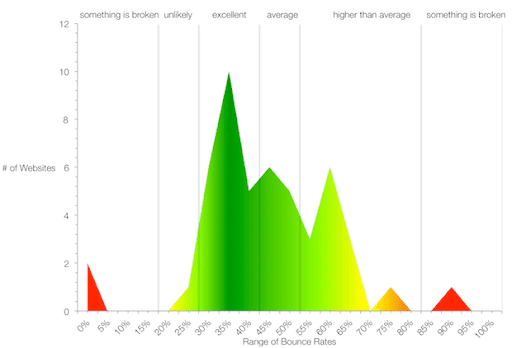
(Source)
A high bounce rate means that visitors are not finding what they want on your site, so you need to improve the content and layout of your landing pages to encourage more conversions.
Here are some of the reasons why people bounce:
- They didn’t find what they were looking for
- The website was too confusing or difficult to navigate
- Their needs weren’t met by your product or service offerings
- The price was too high or low compared to competitors or just not competitive enough
- They couldn’t find an FAQ or help page
3. There are many paths to purchase – it’s hard to track them all.
The conversion rate optimization process is about improving the experience for your visitors and increasing the number of people who buy from your store. The goal is to get more people through the checkout process, which means you want to create an optimal customer journey for each visitor.
This can be tricky because people will interact with your website in many different ways. They might start their search on Google and then click through from there, or they might click on your Facebook ad before landing on your site, or they might see a product on Instagram and come back later to buy it.
You’re not just optimizing one page — you’re optimizing every step in the process between discovery and sale.
In order to optimize your site, you need to understand how people actually use it. This means getting detailed customer data about how customers and potential customers navigate through the site, what they look at, and where they spend the most time.
To do this, you need to capture data on every touchpoint — from when a visitor lands on your home page until they check out and make a purchase (or abandon their cart).
You also need to know the following:
- Which pages do people visit before checking out
- Which pages do they visit after checking out
- Which products are viewed most often
- Which products are abandoned most often, and so on.
4. Unclear descriptions of your offer
Unclear descriptions of your offer are a big challenge faced in e-commerce conversion optimization.
The problem is clear: often, customers do not know what they are buying and why.
You need to give them the right information at the right time before they even make a purchase decision.
Instead of offering a generic description, describe each product in detail so that users can easily recognize it. The problem is that most online retailers are so focused on making sure that their product pages are clear, concise, and well-written that they forget about the description of their products.
If you are selling a smartphone, your customer will want to know the specs, like the size and exact dimensions, storage, camera features, sensors, and more.
If you are selling a dress online, then you need to provide an accurate picture of the dress so that your customers can know if it fits them or not.
For instance, Asos mislabeled their mini skirt as a midi skirt in the image below:
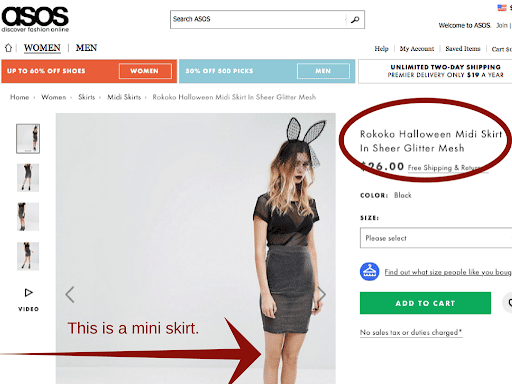
(Source)
5. It’s difficult to keep up with the number of devices you have to optimize for.
The e-commerce industry is growing at a rapid pace, and with it, the number of different devices and screen sizes your customers use to browse your store. The challenge faced in e-commerce conversion optimization is that it’s difficult to keep up with the number of devices you have to optimize for.
Your customers are increasingly using mobile devices to shop online, but we know that not all people use the same device for shopping online.
If you look at the statistics, 79% of smartphone users have bought a product online using their mobile device in the last six months of writing this report.
However, a deeper look at the statistics shows people aren’t only shopping via mobile phones alone. For instance, in 2020, desktops were responsible for 35.7% of all visits to U.S. websites, and tablets were responsible for 3.3% of visitors.
This means that you need to optimize for multiple devices and screen sizes if you want to reach the widest audience possible.
6. Optimizing the checkout page
Optimizing the checkout page is a big challenge faced in e-commerce conversion optimization, especially if you want your online store’s conversion rate to meet up with the average conversion rate in your niche.
The goal of any e-commerce site is to present the user with a clear call to action and relevant product information. The checkout page is an extension of that. It should be designed to make it as simple as possible for users to complete their purchases.
If you look at the statistics, checkout optimization can increase conversions by 35.62%. And one of the major reasons for abandonment during checkout is too long/complicated checkout process.
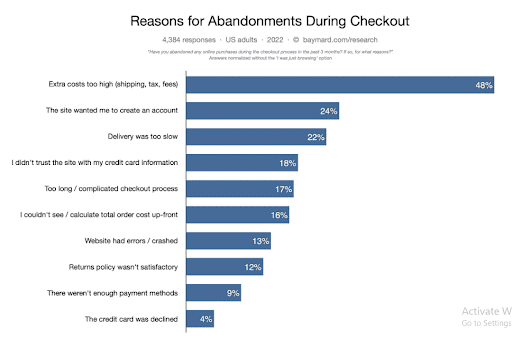
(Source)
Challenging or not – you need to work on optimizing your checkout page in order to increase conversions.
Here are some tips on how you can optimize your checkout page to improve your conversions:
- Use a dedicated shopping cart page.
- Make sure it’s easy for customers to find their place in the queue if they have more than one item in their cart.
- Provide clear instructions on how to proceed with payment, delivery options, etc.
- Ensure that your shipping information is also easy-to-find and clearly communicated with customers before they click “Purchase.”
- Make sure there is no confusion over any additional fees or taxes that may be applicable after purchase.
- Make sure customer service information (such as customer service numbers and email addresses) is clearly displayed on each page of your site.
7. Too many distractions
In e-commerce, we are all about getting people to buy our products. This means that we should have everything set up so that when a potential customer comes across our website, they will not be distracted by anything else on the screen other than what they came there for.
There are many ways to do this, but one of them is by making sure that your website is not cluttered with too many advertisements or offers that pull them away from what they came there for in the first place.
The best way to do this is by having a clean and organized website that displays only those things that are relevant.
As a case study of Weather.com showed, even though the site was getting strong traffic, conversions were low. To turn visitors into subscribers, the Weather Channel cleaned up its homepage—allowing only one action at a time. It increased conversions by 225%.
Ways to overcome the challenges of conversion optimization
1. Mobile and tablet traffic is increasing, and optimizing the experience on these devices is important.
Mobile devices are often used to make purchases – especially small purchases. Customers expect a great shopping experience from your website, no matter what device they’re using.
As per the latest stats, in September of 2022, mobile (excluding tablets) can be credited for 58.72% of web traffic worldwide – while tablet drives 2.1% of the traffic.
That’s not it!
From a study carried out by the Boston Consulting Group, brands that invest in delivering excellent cross-platform see up to 20% higher revenues.
Thus, optimizing the experience of these devices is crucial. If you’re not currently testing a responsive design for your e-commerce site, you could be losing out on sales.
The below tips will help you optimize your e-commerce site to serve mobile users better:
- Make it easy to navigate with a single tap or click
- Use responsive design so that it displays correctly on all devices
- Optimize the user experience (UX) with responsive design elements like buttons, images, and text
- Optimize for cross-device use by using CSS media queries to change the layout based on device size and orientation
2. Creating a hypothesis before testing
A hypothesis is just a simple statement that explains why one thing should affect another – in this case, why your website visitors might convert more if they were given certain information or offered a certain incentive.
If you are creating a product hypothesis, you should consider the following:
- Users’ knowledge level
- Tech skills
- Expectations and needs
- Product security
- Market demand
- Product usability
- Product Features
- Text instructions
It’s important to have a hypothesis before starting your tests because it helps you be more objective about the results. When we don’t have hypotheses, we tend to over-interpret what we see in the data — which leads us to believe we’ve found something when really it could be just random noise.
Let’s consider this example:
We might hypothesize that removing the “buy now” button from the landing page and replacing it with an image of a product will increase overall sales. But what if it doesn’t?
There are many ways we could test this hypothesis:
- We could try using only images and no text on the landing page. If that works better than our current version, we have evidence that images have a positive effect on sales.
- We could try using only text and no images on the landing page. If that works better than our current version, we have evidence that text has a positive effect on sales.
- We could try both images and text on the landing page, but in different places and with different amounts of emphasis given to each one (e.g., moving them around onscreen). If one combination works better than another combination (or if neither does), we’ve learned something about how our audience responds to each type of content (text or image) in different contexts (where it appears onscreen).
Have a look at these examples of hypotheses for Boldare’s product:
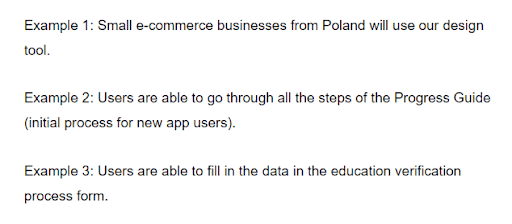
(Source)
3. Display trust signals
Conversion optimization is not just about having a great product or service — it’s also about how your customers feel when they visit your site.
That’s where trust signals come into play.
Trust is one of the most important factors in online shopping, according to several studies from Forrester Research and others. And displaying trust signals on your site can help attract new customers, increase existing customer loyalty, and boost sales, which increases your conversion rates.
In fact, statistics suggest that business legitimacy and concerns about the security of credit card information top the list of the most common trust issues that cause cart abandonment.
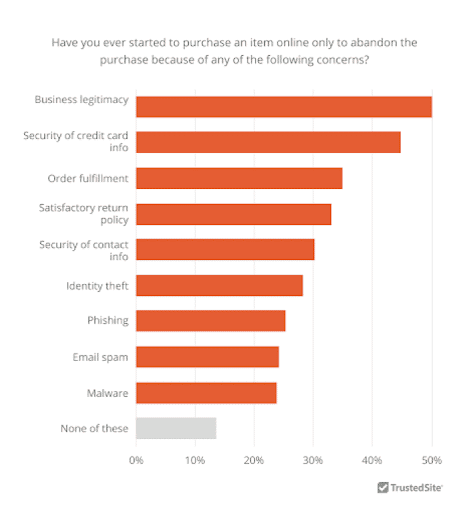
(Source)
There are many ways to display trust signals on your website. Here are some of the most effective ones:
- Displaying a privacy policy
- Displaying your business address and contact details (including phone number)
- Using SSL encryption
- Having a secure checkout facility with 3D Secure payment methods (Visa Secure, MasterCard SecureCode)
- Providing social proof by displaying testimonials and reviews from customers who have bought from you before (when they’re relevant)
For example, when online shoe retailer Shoe Mart ran an A/B test of TrustedSite Trustmark and their own site’s seal, they found that TrustedSite Trustmark generated a 14% conversion lift.
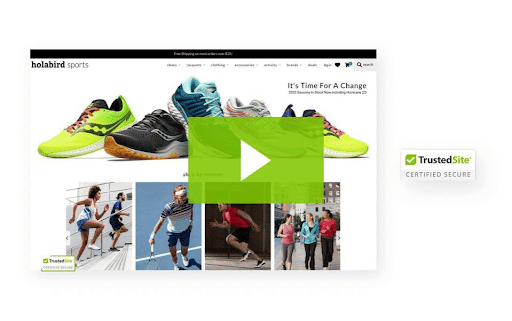
(Source)
4. Use urgency and scarcity to trigger decisions
Urgency and scarcity tactics are potent tools marketers can use to increase conversion rates on their websites or landing pages.
Urgency is what makes someone act now instead of later. Urgency is the need to act quickly or risk losing out on something important. When you see a deal that ends in 5 minutes, that’s an urgency at work.
Scarcity is similar to but different than urgency. Scarcity applies when only a few items are left in stock or some other limited quantity that will soon be gone forever (or at least for a long time).
Urgency and scarcity trigger decisions because it creates an urgency to take action right now before it’s too late. Scarcity can also help boost conversions because it creates a sense of urgency that forces people to decide before they have time to think about it too much.
Case in point: A digital marketer increased sales by 332% by creating a sense of urgency and scarcity.

The marketer launched a Groupon for musicians, giving away $1,250 worth of music-related products for just $69. The deal was good for only 100 hours, and there were just 5,000 packages available.
5. Make it clear what the next steps are
In e-commerce conversion optimization, it’s crucial to make it clear what the next steps are. This is true for your homepage, checkout process, and product pages.
For example, if you’re selling a product with three options, make sure that each option is clearly labeled and easy to find. Or, if you’re selling a single product with multiple variations (for example, size or color), make sure there are clear calls to action for each variation.
While not an e-commerce website, you can still take lessons from this Instagram post.
As you can see, this giveaway post for Melted Soapery spells out the rules and steps required in no uncertain terms.

(Source)
To enter, the participants must follow Melted Soapery on Instagram, share the post to their social media handles, and tag a friend (the more tags, the more entries). Melted Soapery was supposed to select and contact a winner five days later.
This kind of clarity is needed when you design a giveaway or a landing page, or anything that concerns your customers to take action.
6. Add testimonials and social proof points.
If you’re an online business owner, you know that adding testimonials and social proof points is one of the most important things you can do to improve your website’s conversion rate.
They’re also a great way to add credibility to your website, especially when they come from well-known sources. You see it all the time – Amazon uses customer reviews to sell products, and so do many other major retailers.
And for a good reason!
More and more customers are relying on online reviews to gain info about products before they make a purchase. In 2021, 77% ‘always’ or ‘regularly’ read online reviews when looking for local businesses – an increase from 60% in 2020.
What’s more, 93% of customers stated that online reviews influenced their buying decisions.
Here are some ways to incorporate social proof into your e-commerce site:
- Add testimonials from customers who have purchased products from you
- Include reviews from customers who have purchased products from you
- Add reviews from third-party review sites, such as Yelp or Trustpilot.com
An example of a brand doing it right is Sensodyne, a popular toothpaste brand. If you browse Sensodyne’s About page, you straight away notice the “doctor’s recommended brand” stamp.
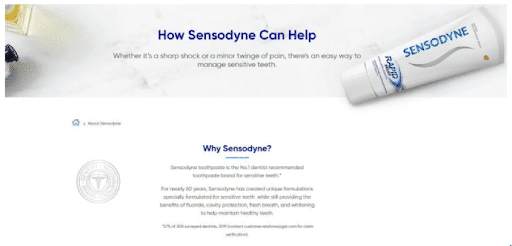
(Source)
You will also find a short paragraph describing Sensodyne as the #1 recommended toothpaste by dentists. It even has a study that backs up its claims.
Final Thoughts
These are just some of the most common issues faced by e-commerce sites and the best way to solve them. With a little luck, you will be able to avoid these mistakes altogether – but it does pay to be aware of what others are doing. After all, when it comes to conversion rate optimization, every extra percentage point matters.



